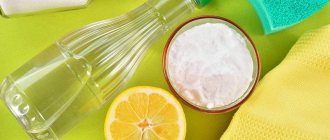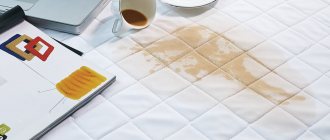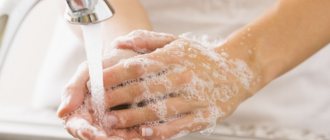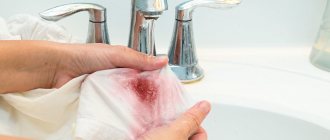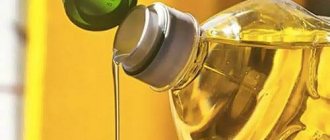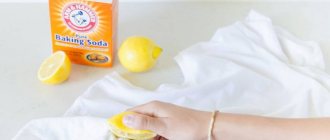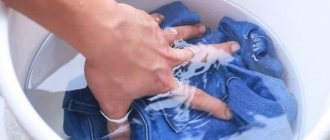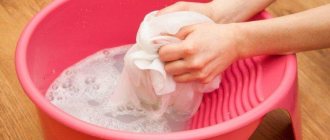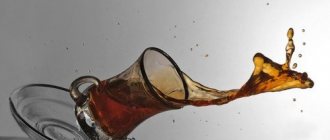Traces from cherries, strawberries, mulberries - dealing with such stains is not difficult if you understand the intricacies of the cleaning process.
The main thing is to start the stain removal process in time, using an effective method selected according to the type of fabric and degree of contamination. We'll tell you how to remove stains from berries below.
Use of ready-made cleaning products
When choosing a suitable stain remover in the store, pay attention to varieties aimed at combating plant-based stains.
Study the manufacturer's instructions for which fabrics the product is suitable for. It is advisable to first distribute a small amount of it on the wrong side to assess the degree of impact on the dye.
Effective stain removers:
- Vanish. It is a universal composition that can cope with both fresh and old berry marks. Stir the powder according to the instructions. Rub into the stain. After 40 minutes, wash off the residue and wash the item. Leave the product on colored clothing for a maximum of 10 minutes.
- Amway SA8. I am attracted by the ease of use of the spray. Spray onto the problem area. Leave for 15 minutes.
- Frau Schmidt. A hypoallergenic stain remover in the form of a soap bar copes with many berry stains, but only when fresh.
- Sarma Active. Due to the five-component complex of enzymes, it easily removes even old marks from various types of fabric, with the exception of wool and silk.
- Eared Nian. Designed for various products, including children's items. Does not cause allergies, eliminates odors and stains, refreshes paints, and returns freshness to white clothes.
- Antipyatin soap. This universal and effective product allows you to remove any dirt, even old ones. It is hypoallergenic, can be used on a variety of fabrics, and does not cause color changes.
Antipyatin Soap
The range of stain removers is extensive, which allows you to select other brands.
How to wash colored clothes at home?
Berry stains are best and easiest to remove immediately after they appear.
It is more difficult to remove juice from colored items than from white ones, because even in extreme cases you cannot use bleaching agents on them. In addition, when working with them there is a high risk of damaging the paint. When using any stain remover, even a professional one, be sure to test it on an inner, inconspicuous piece of fabric. This way you can make sure that the item will not be damaged. You can wash colored items in the following ways:
Using glycerin
- Mix a small amount of glycerin with the white of a raw egg (the mass should remain thick).
- Apply the resulting substance to the stain and leave for 2 hours;
- Wash the item as usual.
To get rid of old and difficult to remove stains, you can use a mixture of glycerin and vodka. But in general, the use of alcohol-containing products on colored items is not recommended.
Using vinegar
- Mix table vinegar and citric acid in equal proportions.
- Soak the stained area in the solution for no more than 20 minutes (a longer period may damage the tissue).
- Wash the item one last time.
Principles for removing berry stains
When starting to fight stains, you should follow simple rules:
- Determine what type of berries left a mark on the clothes.
- They analyze the characteristics of the fabric, finding out what type it belongs to.
- Assess the degree of freshness of the contamination.
- Test the selected cleanser on an inconspicuous area. This procedure will avoid causing additional harm to items, especially those made from dyed or delicate textiles.
- The cloth around the problem area is moistened with clean water, and then the cleaning mixture is applied.
- Scrubbing movements are made in the direction from the perimeter of the stain to the center, placing a white cotton rag under it. This will prevent the contamination from spreading and increasing in size.
- After waiting the recommended time, the product is rinsed under running cool water, and then hand or machine washable with a powder suitable for the fabric.
When cleaning natural linen and cotton products, do not use products containing acids. Alkalies are contraindicated for silk and wool. Synthetics are deformed when exposed to solvents.
Salt
To do this, rub a little salt into the stained area and set it aside for a while. It must absorb the coloring pigment. After this, the salt is brushed off and the item is washed in cool water.
Another option for removing stains is to mix a small amount of salt and water to form a paste. Take a little of this mixture with a clean cotton rag and gently rub the stain from the edge to the center. Then leave for half an hour and then rinse with cold water. The treated item should be washed in the usual way.
Cleaning plain clothes
To remove berries from fabrics dyed the same color, select affordable homemade stain removers that do not cause color changes.
For this purpose, several methods are used:
- If your T-shirt gets dirty from splashes of berries, turn it inside out. Place a piece of plywood and a white napkin under the stain. Soak a cotton pad in ammonia. Wet the stain generously for 5 minutes.
- For light-colored fabric, dissolve hydrogen peroxide in water in a ratio of 1:10. Moisten a cotton swab and saturate the stain. Leave for 7 minutes.
- If the cause of contamination is blueberries, currants or blueberries, then combine ammonia with peroxide in equal parts. Carefully distribute over the contaminated area. Scrub carefully and observe. As soon as the berry splashes dissolve, immediately begin rinsing and washing.
Cleaning plain clothes
How to remove traces of different berries from plain items?
Ammonia and peroxide are a universal remedy for all types of stains, including blueberries, cherries, and lingonberries:
- Soak a cotton swab in ammonia.
- Gently rub the berry marks.
- Rinse.
- Wash it in a way that suits you.
Another fairly simple recipe:
- Prepare a solution of peroxide with water in a ratio of 1:10.
- Soak the tampon in the mixture.
- Treat the problem area.
- Rinse.
Important! If you have hydroperite, dilute 1 tablet in 0.5 glasses of water, proceed in the same order.
Extract the juice from currants and blueberries as follows:
- Make a mixture of peroxide and ammonia in equal proportions.
- Apply the solution to the stained area.
- Wait until it completely dissolves.
- Rinse under running water.
Important! Use this method carefully on colored fabrics.
How to remove berry stains from colored textiles
In order to efficiently clean colored items from stains remaining after berry juice gets in, it is important to choose a product that will not allow the fabric to fade.
The following methods are used in such a situation:
- Combine alcohol with glycerin in equal parts. Mix thoroughly until smooth. Distribute over the stain and leave for up to 40 minutes, controlling the degree of stain removal.
- Glycerin - 30 g, mixed with fresh protein whipped into a light foam, works effectively. Using a cotton swab, generously cover the berry trail with the resulting mass. Leave for 3 hours.
- Make a paste from finely ground salt and fresh lemon juice. Distribute it according to contamination. Leave for 20 minutes and then gently rub the stain until it disappears.
- If strawberries or wild strawberries acted as a contaminant on clothing, then the raw yolk is separated from the chicken egg. Grind it on a ceramic saucer. One same volume of glycerin is injected. A thoroughly mixed homogeneous mass is applied to the berry marks and left for 3 hours.
ARTICLE FOR YOU
How to wash and remove chocolate and cocoa stains from clothes and linen
Giving preference to professional stain removers, select the brand recommended by the manufacturer for colored products. When using, strictly follow the instructions.
Professional stain remover
How to remove stains from berries?
Before removing berry stains, pay attention to some recommendations:
- To remove a berry stain more effectively, try to identify its origin. The method and choice of means for removing it will depend on this.
- Do not forget that old stains are always more difficult to remove than fresh ones.
- Be sure to rinse the sap marks under cool running water to remove the underlying dye.
- Do not use soap, as berry juice contains a natural dye that, upon contact with alkali, is fixed on the fabric and can change its color.
- Increase the concentration of agents and solutions gradually based on the results of their impact.
- Be sure to test the selected product or solution on an inconspicuous area of the product to avoid new stains or damage to the color and fabric.
- Remove the stain from the edges, working towards the middle, this way it will not spread.
Cleaning white items
White clothing is especially susceptible to berry marks. If time is running out and the juice has not had time to dry, you can quickly remove the stain by first soaking the item in hot milk for half an hour.
There are other effective methods in the arsenal of housewives:
- Whey or curdled milk helps even against persistent blueberry marks. Pour the product into a deep enamel bowl and leave the item to be cleaned for 4 hours. This technique allows you to clean dogwood if its splashes end up on clothing.
- Fresh berry stains can be removed using laundry soap. The problem area is moistened and thoroughly rubbed with a soap bar until foam appears. Start rinsing and washing after 2 hours.
- You can solve the problem of removing fresh stains from white textiles using a concentrated composition used for dishes. Apply liberally to the stain and foam. After some time, the result is checked.
- Toothpaste helps to cope with berry impressions that have not had time to dry. It should be light without dyes and have a whitening effect. Using a brush or cotton swab, coat the pre-moistened stain with the product and lightly rub in. After 20 minutes, if the result is good, wash off the residue and wash the item.
- You can use potassium permanganate. Pour 50 ml of water into a glass container, add 1 tbsp. l. vinegar 9% and dissolve crystals of potassium permanganate until a rich crimson color appears. Soak a cotton pad in the liquid and moisten the stain. Then hydrogen peroxide is poured onto the darkened areas using a pipette. Use a soft cloth to wipe off the dirt until it becomes discolored.
Potassium permangantsovka
- If you notice traces of red or black currant berries on a snow-white cotton tablecloth, you need to take an aspirin tablet. It is ground to a powder and diluted in 200 ml of water. Take a cotton swab, soak it well in the solution and place it on the marks, leaving it for an hour and a half. After this, the tablecloth just needs to be washed.
Boiling the white product helps to whiten stubborn traces of berries. This method is suitable for thick cotton or linen fabric.
Using stain removers
In the summer season, when sweet and aromatic berries ripen, you can happily cook delicious compotes and fruit drinks. It so happens that they can leave random marks on your favorite clothes. How to remove a stain from cranberry juice or compote?
In addition to folk remedies, you can also resort to a professional stain remover or bleach. However, you must remember that they are quite aggressive methods. Therefore, be sure to carefully read the instructions on the label before use. It will indicate in detail the method of use and dosage of the product. If there is such a possibility, then test the effect of the composition on the fabric on a small area to be sure that you will not completely ruin your favorite item.
In this article, we described in detail how to remove stains from cranberries, raspberries, currants and other berries. Use one of the above methods and you can easily restore the original appearance of your favorite clothes!
Cranberries aren't just for Thanksgiving anymore. From juices to mixed drinks to BBQ sauces, cranberries are everywhere. We may enjoy the taste, but not the stains cranberries can leave on clothes, carpet and upholstery.
- If the bright red stain is caused by cranberry juice, start by blotting the area with a clean white cloth or paper towel to absorb as much juice as possible. For a small stain, after you have cleaned up the initial spill, dampen a clean white towel with clean water and blot until the remaining color remains. This can remove the stain if you catch it in time.
- For larger stains, the best way to deal with the stain is to hold the cloth directly under a cold water faucet running on full blast. Wash the wrong side of the fabric to remove the stain from the fibers.
- If the stain is caused by cranberry sauce (whole or aspic), use a dull knife or the edge of a spoon to skim off the sauce. Do not rub or rub because you will press the sauce deeper into the fibers of the fabric and make the stain more difficult to remove.
- Cranberries produce tannin, a component of plant color that often shows up as color in the final product. Fresh tannin stains are usually removed by washing table linens or clothing using heavy duty detergent in the hottest water recommended for the fabric. Tide and Persil are powerful detergents that contain enough enzymes to break down stains. Average detergents may not work.
- Never use natural soap such as Fels Naptha in bar or flake form because natural soap makes tannin stains difficult to remove.
- Old cranberry stains may need to be treated with bleach to remove the dye. Chlorine bleach can be used on white clothing and bedding. Use colored dyes or oxygen-based bleaches (brand names OxiClean, OXO Brite or Clorox 2) on colored fabrics.
- If the cranberry stains do not appear completely, repeat the cleaning procedure. Never place a contaminated item in a hot dryer. High temperatures will stain the fabric and make it almost impossible to remove.
- If an item of clothing or table covering is marked dry clean only, point out and describe the stain to your professional cleaner. If you are using a home dry cleaning kit, be sure to treat the stain with the included stain remover before placing the cloth in the kit's cleaning bag.
- For cranberry juice spilled on the carpet, use a white paper towel or an old white cloth to catch as much of the liquid as possible. For cranberry sauces, use a dull knife to remove solids. Do not rub any type of stain! Rubbing will make the stain more difficult to remove as the cranberry penetrates deeper into the fibers of the carpet or upholstery.
- To remove the color component of dye, mix a solution of oxygen-based bleach (brand names: OxiClean, Nellie's All Natural Oxygen Brightener, or OXO Brite) in cold water, following package directions. Dip a clean cloth into the solution and, working from the outer edge of the stain towards the center to prevent spreading, apply the solution to the carpet. Don't oversaturate the carpet. Let the solution sit on the stain for at least 30 minutes before blotting.
- Use a dry, clean white cloth to remove moisture. You do not need to rinse the area. Oxygen bleach solutions turn into clean water within a few hours. Allow to air dry completely away from direct heat or sunlight. Repeat cleaning steps as necessary until stain is removed. When the stain disappears, vacuum to restore the carpet's pile.
- The same cleaning solutions recommended for carpets can be used for upholstery. However, it is important to be careful not to over-saturate the upholstery fabric with the cleaning solution. Excessive moisture in fill pillows can cause problems with mold growth. If the upholstery is silk or vintage, contact an upholstery cleaning professional.
More Stain Removal Tips: Stain Removal A to Z.
Fresh? Soak in whey. Since not everyone always has the product, you can try kneading wet cottage cheese on the stain, or pouring kefir on it - both contain whey. After half an hour, remove the food from the item), rinse it a little under the tap, and soap it up. Then throw it in the washing machine and wash as usual. “Works” on stains from all berries except blueberries. But whether the result will be 100% also depends on the composition of the fabric.
Nowadays there is a very large selection of various stain removers from juices and berries, but it is necessary to take into account the type of fabric so as not to completely ruin the item. If the fabric is durable, you can try Vanish, and if the fabric is delicate, try a regular dishwashing detergent, such as Feri, only after first moistening the stain with cold water, wait a few minutes and rinse, also with cold water. In some cases, regular laundry soap also helps.
- Use of ready-made cleaning products
- Principles for removing berry stains
- Cleaning plain clothes
- How to remove berry stains from colored textiles
- Cleaning white items
- Fighting fresh stains
- Options for removing old marks
- Important Tips
- Solutions for thin and delicate fabrics
- Cleaning denim
Splashes from intensely colored berries leave noticeable marks on clothing. If you do not take action right away, then after the stain dries and is absorbed into the fibers, it becomes more difficult to remove. It is important to have information about effective techniques that allow you to clean things without deforming the fabric.
Fighting fresh stains
For various types of fabric, proven methods are used to get rid of fresh splashes remaining on clothing after picking or processing berries:
- Place the product on any dish, securing it along the edges. Begin pouring boiling water from a kettle onto the fresh stain from the berries in a thin stream until the stain disappears. Viburnum and blackberries are quickly washed using this method.
- Ripe cranberries can contaminate things if the juice of this swamp berry gets on them. It is recommended to lay the product on the table and spread wet cottage cheese over the marks. After half an hour, it is removed, and the fabric is rinsed and soaped. In this form they are sent to the washing machine.
- Fresh splashes of different berries should be immediately covered with plenty of table salt. When the juice is absorbed, shake it off and replace it with fresh one. If possible, remove the dress and lightly moisten the contaminated areas. Fine salt is applied on top and left for 3 hours.
- Plum, cherry plum or sloe can be washed well if glycerin mixed in vodka acts as a cleaning solution. The components should be taken in equal volumes. Soak a cotton swab and carefully wipe off all dirt. If necessary, repeat the procedure several times.
- Rose hips will not harm clothes, stains from the berries of which are moistened and wiped with laundry soap so that the foam covers them with a thick layer. “Eared Nyan” stain remover is poured from a pipette on top. After 15 minutes, wash by hand. After this treatment, the rosehip is completely removed.
- Lemon juice, 2 tbsp. will help remove currant stains. l. which is stirred in milk - 1 liter at room temperature. The amount of solution can be increased by observing the proportions of the components, since the product should be soaked completely for 2 hours. And also with the help of this composition, lingonberries, cherries and cherries are well removed. You can remove dirt from the same berries using lemon juice dissolved in a 1:1 ratio in table vinegar (9%).
- You can remove traces of dark grape juice by combining washing powder - 1 tbsp. l. and table vinegar (9%) - 1 tsp. Dissolve the resulting slurry in a liter of slightly heated water. Soak the item of clothing to be treated for an hour, and then use a cotton swab to wipe off any remaining dirt.
- Irga can be effectively cleaned if all spots are generously moistened with vinegar (9%) before washing.
ARTICLE FOR YOU
How and with what to remove plasticine stains: from clothes, hair, wallpaper, toys
Vinegar 9%
It is very difficult to remove mature cloudberries, barberries and sea buckthorn from the surfaces of textile products. These berries leave clearly visible orange spots. Starch, talc or soda should be immediately applied to fresh stains.
After 15 minutes, the item is shaken out well and soaked in dish soap, 2 tbsp. l. which is diluted in hot (70˚C) water - 2 liters. Leave for 15 minutes.
On thick, plain fabric, you can use a mixture of ammonia and turpentine for sea buckthorn. The components are taken in equal shares. Allow to sit on dirt for 30 minutes. During treatment, it is necessary to protect the respiratory system with a mask and hands with gloves.
Boiling water
A universal way to get rid of a completely fresh stain is to rinse it with hot water. To do this, stretch the cloth with the contaminated area over any large container, and then pour boiling water from a kettle onto the stains in a thin stream. When the stain is gone, the item must be washed using laundry soap or washing powder.
It is important to remember that you cannot completely soak clothes in boiling water. Thus, contamination can stain other areas of the item, and colored fabric can fade due to the high temperature of the water.
Options for removing old marks
Old, stubborn traces of berries are more difficult to clean. It is recommended to stir half a glass of salt in 5 liters of warm water. Before washing clothes, soak them in the resulting solution for 2 hours.
Other methods:
- After harvesting, you may not immediately notice that the delicate raspberries have left their imprints on the clothes. To correct the situation, dissolve 2 g of citric acid in a glass of water. The contaminated area is immersed in the liquid for 30 minutes. Check the result. If necessary, repeat the procedure.
- Combine tartaric acid and ethyl alcohol in equal volume fractions. For natural fabrics, the culprit of the marks on which was grapes (blue, white), you can take citric acid and alcohol in a ratio of 2:10. Heat the mixture using a water bath to 40˚C. Moisten a cotton pad and wipe off any remaining traces of berries. Rinse the clothes, alternating clean water and a solution of ammonia - 1 tsp. for 2 liters of water.
- Having noticed persistent traces of sea buckthorn berries, take refined vegetable oil - 100 ml and with washing powder - 1 tbsp. l. For white fabric, you can add 1 tsp. powdered bleach. Rub part of the mass into the stain with your finger, and dissolve the remainder in hot (80˚C) water - 10 liters soak the clothes for 12 hours.
- Dried elderberry is wiped off with a piece of soft rag soaked in a liquid of table vinegar (6%), mixed in equal volumes with lemon juice.
- If tomato or physalis left stains on colored or plain clothes, prepare a paste from 1 tbsp. l. ammonia with the addition of 1 tsp. salt. The stain must be moistened, the resulting mixture spread over it and left for an hour.
Ammonia
If you notice bright marks left by honeysuckle on your trousers or T-shirt, prepare a mixture of vodka and lemon juice in equal proportions. Using a cotton pad, apply the liquid to the stain and gently wipe it off.
Then take a piece of soft cloth, moisten it with ammonia, which is pre-diluted with water 1:2, and further treat the stain.
How to remove berry stains?
Depending on the origin of the stain, choose the remedy that is most accessible to you and proceed. You will need:
- hot water;
- salt;
- vinegar;
- lemon acid;
- lemon juice;
- ammonia;
- alcohol;
- hydrogen peroxide;
- glycerol;
- egg yolk;
- washing powder;
- potassium permanganate;
- dishwashing detergent;
- laundry soap 72%;
- oxygen bleach;
- stain remover;
- toothpaste;
- special chemical concentrates.
The easiest way is boiling water, but only if the stain is fresh:
- Boil a few liters of water.
- Depending on the size of the stain, choose a container over which to stretch the fabric.
- Secure the material so that it does not sag.
- Pour boiling water over the stain until it disappears completely.
- Wash with soap.
Important! Do not completely soak the item in boiling water - the dye may transfer to other parts of the item, and if the clothing is colored, it may fade at high temperatures. For extensive contamination, soak the item of clothing to be cleaned in a large container so that it can be freely contained in the water.
Important Tips
Berry stains don't just appear on items of clothing. Sometimes you need to clean a sofa, carpet or mattress. In such a situation, the following substances provide effective assistance:
- To restore the decor to the upholstery, ammonia, glycerin and vodka are mixed in a ceramic cup, maintaining a ratio of 1:1:3. Soak a cotton pad with the resulting product and wipe off the berry stain, which is first moistened with clean water from a spray bottle. When the dirt disappears, take a soft textile napkin, slightly moisten it and remove all residues. Wipe with a dry towel and leave until completely dry.
- To clean a mattress or sofa, add a little water to baking soda until the consistency of a not very thick paste is obtained. Apply and treat stains with a not very stiff brush. Then the treatment is carried out with a solution of vinegar (9%) in water in a ratio of 1:4. Use a damp cloth to remove any remaining dirt. The surface is wiped with a dry terry towel and left to dry.
- A mixture of washing powder without abrasive and bleaching additives, soda, table vinegar (9%) vinegar and water in a ratio of 1:1:4:6 cleans the upholstery of upholstered furniture well.
If, after berry splashes, you need to restore the cleanliness of the carpet flooring, you must take into account that aggressive chemicals and hard brushes are not used for natural pile. All movements are performed along the pile. You cannot use hot water, as the rug may become deformed. After cleaning, it is thoroughly dried to prevent the formation of fungus.
Fresh stains are removed using a well-known method using salt. If you notice already dried traces of berries, first remove the dust from the contaminated area. Then mix the dish gel with table vinegar (6%) and water, maintaining a ratio of 1:1:2. Clean all marks thoroughly and wipe with clean water.
ARTICLE FOR YOU
How and with what to wash and remove iodine stains from clothes and linen
For a light-colored carpet, stir baking soda in 100 ml of hydrogen peroxide - 2 tbsp. l. Distribute over the area affected by the berries. After 15 minutes, wipe with a cloth moistened with clean water. Repeat until all traces are completely removed.
Persimmon leaves noticeable marks. If the juice has already dried and been absorbed into the upholstery of a chair or carpet, prepare a paste of hydrogen peroxide and white chalk ground to a powder. The resulting creamy paste is applied in a thick layer to the contaminated areas and kept for at least 12 hours, allowing it to dry completely.
To make the effect more pronounced, cover the problem area with cling film. Then the dirt is wiped with a soft cloth moistened first with a soap solution and then with water.
Homemade and store-bought remedies will help remove stains of berries and fruits from white and light-colored materials:
Boiling water. A simple and affordable method for light and permanently colored materials that are not afraid of high temperatures . If you are not sure that the fabric will not fade, use the method only for non-colored laundry. Note: this same method can effectively remove greasy stains from oils and fatty foods. Once the ink has been placed, boil the water. Place soiled clothes in the sink (if it is not ceramic!) and water there. My sister “cracked” her sink by pouring boiling water from potatoes into it. In general, be careful with ceramics. Prepare the item, either in a sink that is not afraid of high temperatures, or by stretching the damaged area well over a metal dish (secured with clothespins) and pour boiling water directly onto the stain in a thin stream. Helps get rid of old sap stains if you pour boiling water long enough for them to disappear.
Opinions differed again about boiling. Some people advise boiling things by heating them directly in water, others say that everything will only spread across the fabric. I think if this happens, then everything will boil and wash off at once.
Dairy products. Excellent bleaches. Previously milk was used to whiten stoves and houses). Soak the stained area in hot milk for a couple of hours, and you will see everything with your own eyes. Works well on newly applied stains. To enhance the effect, it is recommended to add a little citric acid. Kefir, yogurt, sour cream. For “aged” marks it is better to use fermented milk products. The principle is the same - soak for a long time in kefir or yogurt, and spread sour cream thickly. Add a little lemon - a little more acid will not hurt in the fight for freedom from blueberry dirt)
Lime, lemon, citric acid.

